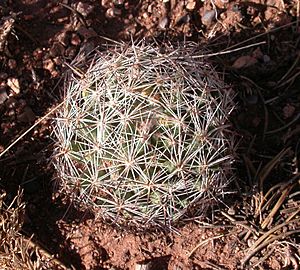Escobaria vivipara facts for kids
Quick facts for kids Escobaria vivipara |
|
|---|---|
 |
|
| Scientific classification | |
| Kingdom: | |
| (unranked): | |
| (unranked): | |
| (unranked): | |
| Order: | |
| Family: | |
| Subfamily: | |
| Tribe: |
Cacteae
|
| Genus: |
Escobaria
|
| Species: |
E. vivipara
|
| Binomial name | |
| Escobaria vivipara (Nutt.) Buxb.
|
|
| Synonyms | |
|
List
|
|
Escobaria vivipara is a species of cactus known by several common names. These include spinystar, viviparous foxtail cactus, pincushion cactus, and ball cactus. It grows naturally in North America. You can find different types of this cactus from Mexico up to Canada. Most of these types live in the Mojave and Sonoran Deserts.
Contents
About the Spinystar Cactus
This cactus is usually small and round. It can grow up to about 15 cm (6 inches) tall. Often, it stays even smaller, looking more like an oval or a ball. The cactus is covered with many straight white spines. These spines are about 1 to 2.5 cm (0.4 to 1 inch) long. They are arranged in a star shape. The cactus blooms with colorful flowers. These flowers can be yellow, pink, red, or purple. They are about 2 to 5 cm (0.8 to 2 inches) wide.
Different Types of Spinystar Cactus
There are several different types, or varieties, of Escobaria vivipara. Here are some of them:
- E. v. var. arizonica (Arizona spinystar) – This type grows in the desert areas of the southwestern United States.
- E. v. var. bisbeeana (Bisbee spinystar) – You can find this variety in Arizona and New Mexico.
- E. v. var. deserti (Desert spinystar) – This type is also found in the desert southwest.
- E. v. var. kaibabensis (Kaibab spinystar) – This variety mostly lives in Arizona.
- E. v. var. neomexicana (New Mexico spinystar) – This type is native to New Mexico and Texas.
- E. v. var. vivipara – This variety is found as far north as Manitoba, Canada.
Where It Grows
Today, the spinystar cactus grows across a large area in western North America. However, a very long time ago, in the early Holocene era, it grew in different places. Scientists have studied old pollen to map where this cactus used to live. For example, during the Late Wisconsin period, Escobaria vivipara was found in the Waterman Mountains in northern Arizona. It does not grow there anymore today.
In the US state of Minnesota, this cactus is considered a threatened species. This means it is rare there. Minnesota is the easternmost place where it naturally grows. It is found in a small part of western Minnesota. There, it grows in cracks and rocky areas of granite. One group of these plants was first noted in 1898 as "quite abundant." But due to farms taking over its habitat, its numbers have gone down. The remaining plants are also at risk from people taking them without permission. Some people like to plant them in rock gardens or on windowsills.
Images for kids
See also
 In Spanish: Escobaria vivipara para niños
In Spanish: Escobaria vivipara para niños


